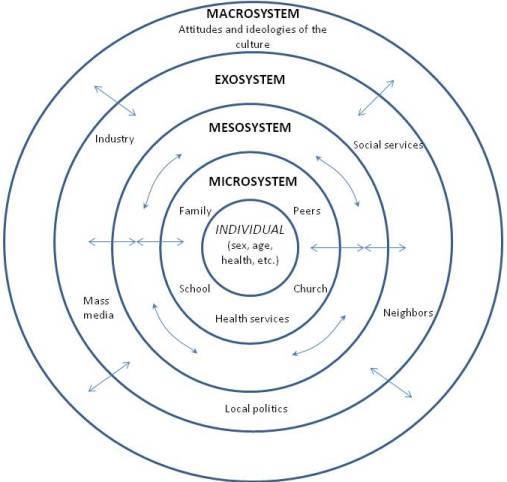Other Enculturation Agents
Ecological Systems Theory
Contextual characteristics, such as the neighborhood, school, and social networks, also affect enculturation, even though these settings don’t always include both the child and the parent (Brofenbrenner, 1989). For example, Latina mothers who perceived the neighborhood as more dangerous showed less warmth with their children, perhaps because of the greater stress associated with living in a threatening environment (Gonzales et al., 2011). Urie Bronfenbrenner was a Russian-born American developmental psychologist who is known for his ecological systems theory of child development. His scientific work and his assistance to the United States government helped in the formation of the Head Start program in 1965.

Bronfenbrenner’s research and his theory was key in changing the perspective of developmental psychology by calling attention to the large number of environmental and societal influences on child development. Bronfenbrenner saw the process of human development as being shaped by the interaction between an individual and his or her environment. The specific path of development was a result of the influences of a person’s surroundings, such as their parents, friends, school, work, culture, and so on.
According to Melvin L. Kohn, a sociologist from Johns Hopkins University, Bronfenbrenner was critical in making social scientists realize that, “…interpersonal relationships, even [at] the smallest level of the parent-child relationship, did not exist in a social vacuum but were embedded in the larger social structures of community, society, economics and politics.”
Peer and Sibling Relationships
Parent-child relationships are not the only significant relationships in a child’s life. Peer relationships are also important. Social interaction with another child who is similar in age, skills, and knowledge provokes the development of many social skills that are valuable for the rest of life (Bukowski, Buhrmester, & Underwood, 2011). In peer relationships, children learn how to initiate and maintain social interactions with other children. They learn skills for managing conflict, such as turn-taking, compromise, and bargaining. Play also involves the mutual, sometimes complex, coordination of goals, actions, and understanding. For example, as infants, children get their first encounter with sharing (of each other’s toys); during pretend play as preschoolers they create narratives together, choose roles, and collaborate to act out their stories; and in primary school, they may join a sports team, learning to work together and support each other emotionally and strategically toward a common goal. Through these experiences, children develop friendships that provide additional sources of security and support to those provided by their parents.
Peer relationships can be challenging as well as supportive (Rubin, Coplan, Chen, Bowker, & McDonald, 2011). Being accepted by other children is an important source of affirmation and self-esteem, but peer rejection can foreshadow later behavior problems (especially when children are rejected due to aggressive behavior). With increasing age, children confront the challenges of bullying, peer victimization, and managing conformity pressures. Social comparison with peers is an important means by which children evaluate their skills, knowledge, and personal qualities, but it may cause them to feel that they do not measure up well against others. Also, with the approach of adolescence, peer relationships become focused on psychological intimacy, involving personal disclosure, vulnerability, and loyalty (or its betrayal)—which significantly affects a child’s outlook on the world. Each of these aspects of peer relationships requires developing very different social and emotional skills than those that emerge in parent- child relationships. They also illustrate the many ways that peer relationships influence the growth of personality and self-concept.
Education
As previously stated, caretakers serve the role of being primary enculturation agents of their young in any given society. If parents serve as the #1 enculturation agent, education would likely be the second most important source of enculturation for any child.
Education is the process of facilitating learning, or the acquisition of knowledge, skills, values, beliefs, and habits. Educational methods include storytelling, discussion, teaching, training, and directed research. Education frequently takes place under the guidance of educators, but learners may also educate themselves. Education can take place in formal or informal settings and any experience that has a formative effect on the way one thinks, feels, or acts may be considered educational.
Culture, education, and society are all interconnected concepts that work to enculturate a child. Education models are based on the ideals and principles of society, and then its educated citizens go on to become influencers of that society’s culture. Researchers Markus and Kitayama (2010) refer to the systemic influence of culture and self as mutual constitution, and point out that individuals are simultaneously being shaped by culture while also influencing it. Regardless of the method of education, schooling serves as both a reflection of the priorities and values of that society, while also enculturating its young to contribute to that culture. For example, core American values of competition, choice, and independence can be seen in the way we structure our formal education system. Parents and students often expect to play a role in choosing curriculum, classes and competition for academic and athletic status is expected within schools. Similarly, in the United States the government dictates larger educational goals and resources, while state and local districts pass mandates based on the democratic wishes of larger society. In contrast to Westernized systems of education, many East Asian education models are based on uniform standards of academic rigor, student conformity, and respect for authority.

